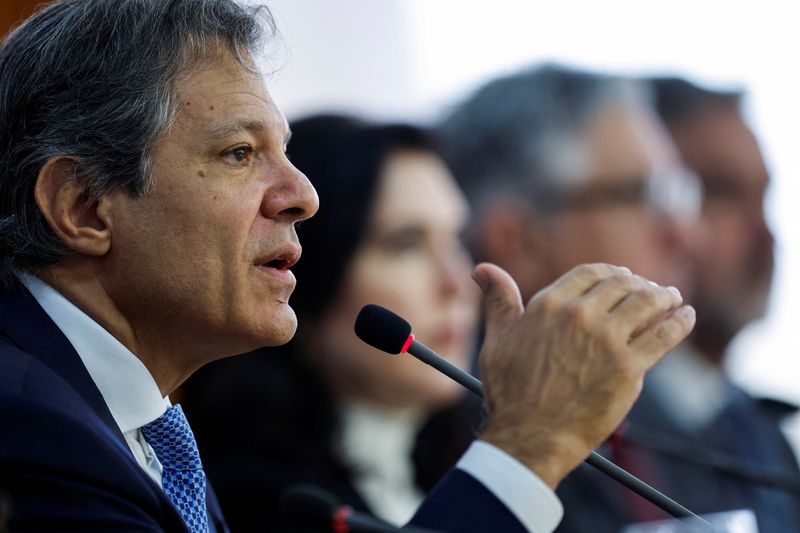SAO PAULO/BRASILIA (Reuters) -Brazil’s currency rebounded on Friday from record intraday lows after congressional leaders said they would put the brakes on government income tax reform, and the finance minister stressed that fiscal commitment goes beyond a new spending cuts package.
“We won’t be able to do everything that needs to be done with a silver bullet. This set of measures is not the grand finale of what we need to do,” said Minister Fernando Haddad at an event hosted by banking lobby group Febraban.
Later, in an interview to Record TV, he said the government could resume discussions for new fiscal measures in two or three months if needed.
Investors have been doubtful about the scope and effectiveness of the measures presented by President Luiz Inacio Lula da Silva’s administration this week to slow down expenses to sustain a fiscal framework passed last year.
Brazil’s gross public sector debt rose to 78.6% of gross domestic product in October from 78.2% in September and economists say it is on a path to hit 91% by 2030, fueling market skepticism about the framework’s ability to stabilize it.
Haddad said on Friday at the event that no one in the government was trying to sell fantasies or magic, emphasizing a firm commitment to slashing the primary budget deficit.
Before his remarks, Lower House Speaker Arthur Lira and Senate head Rodrigo Pacheco said that broader income tax exemptions proposed by the Lula administration were a topic for the future, and the near-term focus would be on passing spending cuts.
The Brazilian real, which in early morning weakened to a record low of 6.11 per dollar following a two-session sell-off, pared losses and ended the session to trade slightly down, but still marking a fresh closing record ever at 6 per greenback.
Lira said on social media that fiscal responsibility was a “non-negotiable” for the lower house, while Pacheco in a statement said a potential income tax reform would only go through if there was fiscal room.
“The remarks by the heads of both houses of Congress are extremely relevant and indicate that there is an effort to regain some of the trust that was lost in the process,” analysts at brokerage XP (NASDAQ:XP) said.
FX JITTERS
The government on Thursday detailed a package announced a day earlier aimed at achieving more than 70 billion reais ($11.8 billion) in savings over the next two years.
But the measures failed to ease market fiscal concerns amid rising mandatory expenditures growth, leading to a sharp decline in Brazilian assets.
Following an over 20% decline of the real year-to-date, incoming central bank governor Gabriel Galipolo said on Friday that the monetary authority does not target or defend any specific exchange rate level, intervening only in cases of “market dysfunction.”
Speaking at the same event as the finance minister, Galipolo, the current central bank monetary policy director, added that the exchange rate is floating, which is important for absorbing shocks.
The market had expected the fiscal package to focus exclusively on spending cuts, consistent with previous statements by Haddad, who had indicated that changes to income tax rules would only be presented next year.
But the government unexpectedly announced an income tax reform, raising the exemption threshold to 5,000 reais ($842) per month from 2,824 reais, while compensating for the revenue loss with higher taxes on those earning over 50,000 reais.
“What weighed heavily was the indication of including the income tax reform alongside the package,” said Daniel Leal, strategist at BGC and former coordinator of public debt operations at the Treasury.
“The market fixated on the signal of more fiscal stimulus,” he added.

Haddad said at the event on Friday that the Lula administration was “aligned” with Lira and Pacheco on the fiscal issue, and reiterated that any income tax reform would only be voted on by lawmakers if it proved to be fiscally neutral.
The government stressed that spending control measures would ensure 327 billion reais in savings from 2025 to 2030, with Congress expected to approve them later this year.
To read the full article, Click Here

